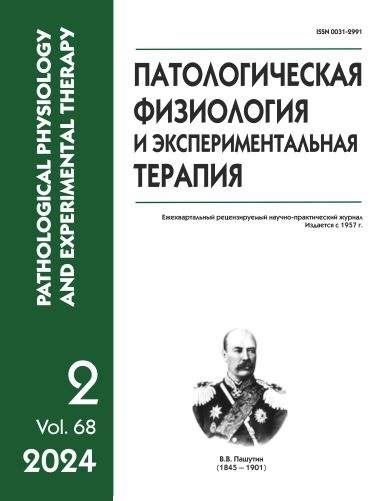Effects of the combined isolation stress and cold stress on pain sensitivity of rats
Abstract
Background. The effects of isolation and cold in humans and animals can occur as a stress response to an extreme stimulus. Stress is a systemic reaction of the body and has a modulating effect on pain sensitivity. The nature, duration, and intensity of stress exposure largely determine the pattern of changes in pain sensitivity. Stress exerts multidirectional effects on pain. In some cases, an exposure to acute stress leads to a decrease in the pain sensitivity of mammals, stress-induced analgesia, while in other cases associated with repeated or chronic stress, stress-induced hyperalgesia occurs. The direction of changes in pain sensitivity may reflect the adaptive or maladaptive nature of adaptive reactions.
Aim. To study the pattern of changes in pain sensitivity in male Wistar rats in the hot plate test under the conditions of combined isolation and cold stress.
Methods. Changes in individual pain sensitivity in animals were assessed using the standard analgesiometric hot plate test. Rats were divided into three groups: control intact, unstressed animals (n=12); animals exposed to isolation (n=17); and animals exposed to combined isolation and cold (n=17). To study the effect of isolation, animals from a common cage were moved to individual cages for 4 hours per day during 8 days and kept at room temperature (23±1°C). To study the combined effects of isolation and cold, animals from a common cage were also moved one at a time to a cage for 4 hours per day at 4°C during 8 days. Pain response thresholds (PRT) were measured before and after the exposure on days 1 and 8, as well as on the next day (day 9) after the end of experiment. In intact control animals, PRT was measured at the same time points as in animals exposed to isolation and cold.
Results. Studying the dynamics of pain sensitivity with the hot plate test showed that the exposure to isolation, as well as the combined exposure to isolation and cold, decreased the pain sensitivity thresholds, i.e., caused stress-induced hyperalgesia. The decrease in PRT under the conditions of combined isolation and cold was more pronounced compared to isolation alone.
Conclusion. The development of stress-induced hyperalgesia due to isolation and cold stress reflects the maladaptive nature of changes in pain sensitivity.






